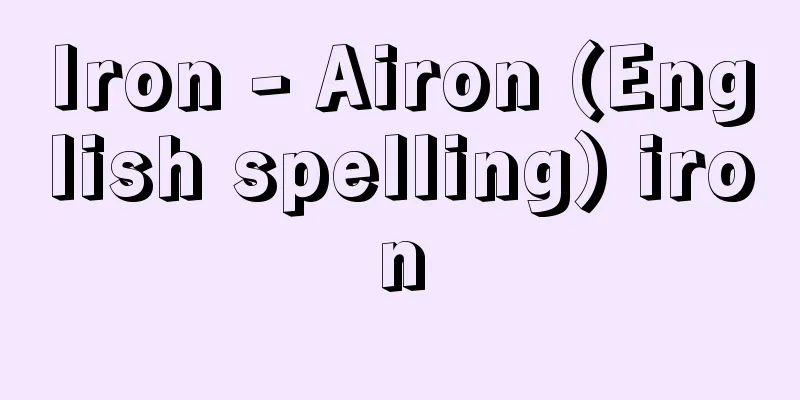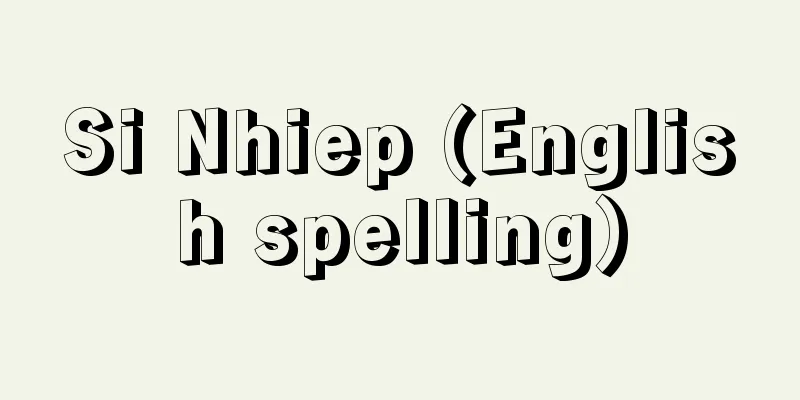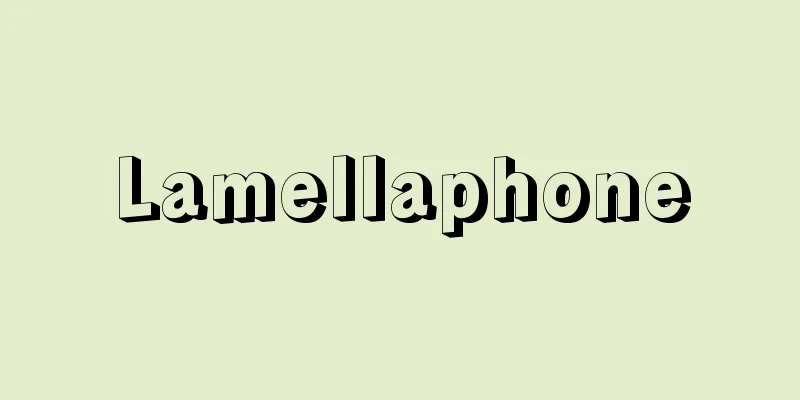Iron - Airon (English spelling) iron

|
This is an instrument used in the finishing process of Japanese and Western dressmaking and laundry, using heat and pressure to remove wrinkles from fabric, create creases, and shape clothing. [Kumada Yasuharu and Fukai Akiko] historyAs its name suggests, the iron is said to have originated in the mid-19th century in England, when a thick iron plate with a handle was placed over a coal fire to remove wrinkles from clothes. Prior to this, in the 16th century, a trowel was used to shape the ruffs (pleated collars) that were popular at the time. In Japan, a fire iron with a wooden handle attached to a metal brazier has been used since ancient times, and from the mid-Edo period, a bamboo trowel was used. Western fire irons (irons) were introduced from England around the end of the 19th century. Today's electric irons have only been used since the 20th century, when the heat source rapidly changed to electricity with the development of nichrome wire. [Kumada Yasuharu and Fukai Akiko] Types and StructureDepending on the heat source, they can be classified as gas or electric. Gas irons have a gas burner inside and were mainly used for professional use, but are rarely used nowadays due to the inconvenience of adjusting the heat and the inconvenience of use. Electric irons have two heating methods: mica heater type, in which a heating element made of nichrome wire wrapped around a mica plate is attached to the base metal and heat is transferred to the base, and sheath heater type, in which a rod-shaped heating element in which nichrome wire is wound in a coil and stored in a metal tube, insulated and sealed with magnesium oxide, is embedded in the base metal and heat is transferred to the base. According to the current Japanese Industrial Standards (JIS), irons are classified into dry irons and steam irons by function. Weight is not a big issue, and with the development of heating elements and lightweight metal materials, they are becoming lighter and more thermally efficient. However, for professional use, the more weight there is in addition to the wattage, the better the effect. For home use, irons that consume 400 to 700 watts and weigh 1,000 to 1,300 grams are used. Most household irons are automatic with an automatic temperature regulator, and have a bimetal current interrupter inside to keep the temperature constant. The temperature can be adjusted by turning a dial to adjust the bimetal contact distance. In recent years, irons with a fluororesin coating on the base metal have become mainstream. This is effective in improving the sliding of the iron with the fabric and preventing it from burning when ironing. There are two types of steam irons: tank type (water in a tank inside the iron body is boiled by electric heat, and the resulting steam is sprayed from a hole on the bottom) and drip type (water from the tank is dripped little by little onto the heating element at the bottom to turn it into steam, which is then sprayed from a hole). Drip type irons have more steam nozzles and emit steam widely and evenly, which makes them more efficient and is more widely used. The nozzles are designed to be easy to clean, as they have the disadvantage of accumulating limescale if the water used is not distilled water. Both types do not require a spray bottle, so they are effective for finishing wool products. Drip type steam irons also come in cassette tank types, where the water tank can be removed from the iron body. This is easy to use as it can be filled and drained using a cassette tank. [Kumada Yasuharu and Fukai Akiko] UsageThe effectiveness of ironing takes advantage of the fact that fabrics have the ability to maintain a certain shape for a certain period of time when they are moistened with the right amount of moisture and heat and pressure are applied, and is the combined effect of temperature, contact time, moisture, pressure, etc. Therefore, ironing is most effective when the appropriate temperature is selected and pressure is applied to fabrics that are moderately moist. The appropriate temperature differs depending on the type of fabric, so care must be taken. However, recently, the appropriate temperature for each type of fabric has been indicated, and steam irons, which use both heat and steam, have become easy to use and can be used to easily achieve the desired finishing purpose. Depending on the fabric, a pressing cloth may be placed over the fabric when ironing on the ironing board, but care must be taken when doing this, as the moisture applied must be completely dried or the fabric may lose its shape or wrinkle. In addition to the above irons, there are also other types of irons, such as small, lightweight travel irons, electric irons for Japanese dressmaking that have the same structure as irons, and hair irons, etc. There are also trouser presses for creating creases in trousers. [Kumada Yasuharu and Fukai Akiko] [Reference item] | | |©Tai Aoki Structure of a steam iron (drop type) ©Shogakukan "> Steam generation method for steam irons Source: Shogakukan Encyclopedia Nipponica About Encyclopedia Nipponica Information | Legend |
|
熱と圧力によって、布地のしわを伸ばし、折り目をつけ、衣服の形を整えるなど、和洋裁や洗濯の仕上げに用いる器具をいう。 [熊田泰治・深井晃子] 歴史アイロンは、その名「鉄」の意のとおり、19世紀中ごろ、イギリスで取っ手をつけた鉄の厚板に石炭のおき火をのせて、衣服のしわを伸ばしたのが始まりといわれている。これよりも前、16世紀には当時流行したラフ(襞襟(ひだえり))を形づくるためのこてが用いられていた。日本では、古くから金属製の火桶(ひおけ)に木製の柄がついた火熨斗(ひのし)が使用され、江戸中期ごろからは笹鏝(ささごて)が用いられた。19世紀末ごろにはイギリスから西洋火熨斗(アイロン)が導入された。今日のような電気アイロンは、ニクロム線の開発によって熱源が急速に電気に変わった20世紀以降用いられるようになった。 [熊田泰治・深井晃子] 種類と構造熱源により、ガス、電気に分けられる。ガスアイロンは内部にガスバーナーの装置のあるもので、おもに職業用に使われたが、火力の調節や使用の不便のため現在ではほとんど使用されていない。電気アイロンの発熱方式には、雲母(うんも)(マイカ)板にニクロム線を巻き付けた発熱体を底金に取り付け、熱を底面に伝えるマイカヒーター式と、ニクロム線をあらかじめコイル状に巻き、金属管内に収納し、酸化マグネシウムにより絶縁、封印した棒状の発熱体を底金の中に埋め込み、底面に熱を伝えるシーズヒーター式とがある。アイロンの種類は現行日本工業規格(JIS(ジス))によると、機能別に、ドライアイロンとスチームアイロン(蒸気)に分類される。重量はあまり問題にされず、発熱体や軽量金属材料の開発で、軽くて熱効率のよいものへ変わりつつある。ただし職業用としては、ワット数に加えて重量があるほど効果がよい。家庭用としては、400~700ワットの消費電力で、重量は1000~1300グラムのものが用いられている。家庭用アイロンは、ほとんど自動温度調節器付きの自動アイロンとなっており、内部にバイメタルによる電流の断続装置があり、温度を一定に保つことができ、ダイヤルを回し、バイメタルの接点距離を調節すれば温度調節ができる。近年、アイロンの底金にフッ素樹脂塗装を施したものが主流になってきた。アイロンかけの際、繊維との滑りをよくし、焦げ付きを防止するのに有効である。スチームアイロンには、タンク式(胴体内のタンクの水を電熱で沸騰させ、できた蒸気を底面の穴から噴射させる)と、滴下式(タンクの水を少しずつ底の発熱体の上に滴下させて蒸気にし、穴から噴射させる)とがある。滴下式のほうが蒸気の噴射口が多く、広く均一に蒸気が出るので能率よく仕上がり、広く使われている。使用する水が蒸留水でないと水あかがたまる欠点があるため、噴射口は手入れのしやすい構造になっている。いずれも霧吹きの必要がないので、羊毛製品の仕上げに有効である。なお、滴下式スチームアイロンには、水タンク部分をアイロン本体から取り外せるカセットタンク形式のものがある。これはカセットタンクで注排水が行えるので、使いやすい。 [熊田泰治・深井晃子] 使用法アイロン仕上げの効果は、適度の湿度を含ませて熱と圧力を加えると、繊維には一定の形を相当期間保つ性質があることを利用したもので、温度、接触時間、水分、加圧力などの総合効果である。したがって、アイロンの適正温度を選び、適度に湿っている繊維に加圧すると、アイロンの効果は大きい。適正温度は繊維の種類によって異なるので、注意が必要である。しかし最近では、おもな繊維に対する適正温度が表示されており、また熱と水蒸気を併用するスチームアイロンは、仕上げの目的が簡単に得られて使いやすくなっている。アイロン台の上で、布地によっては当て布をあてながらアイロンをかけるが、この際、与えた湿気は完全に乾かさないと、型くずれやしわを生じやすいので、注意する必要がある。 なおアイロンにはこのほか、用途により、小型軽量の旅行用アイロン、アイロンと同一構造の和裁用電気ごて、毛髪用のアイロンなどもある。また、ズボンの折り目つけ用にはズボンプレッサーがある。 [熊田泰治・深井晃子] [参照項目] | | |©青木 堆"> スチームアイロンの構造(滴下式) ©Shogakukan"> スチームアイロンの蒸気発生方式 出典 小学館 日本大百科全書(ニッポニカ)日本大百科全書(ニッポニカ)について 情報 | 凡例 |
>>: Irony - Irony (English spelling)
Recommend
Cape Sata
Located at the southernmost tip of the Osumi Peni...
Mountain Village Work Team - Sansonkosakutai
Organisational activities carried out by the Japan...
Yue King Temple
The temple of King Yue (E King, Yue E King) stands...
Indian cobra
…It is found in the tropical and subtropical regi...
Clematis japonica (Clematis japonica)
A deciduous vine of the Ranunculaceae family. It i...
Shigeharu Kikuchi
⇒ Yoshitake Kikuchi Source: Kodansha Digital Japan...
Stoichiometric equation - kagakuryorontekihoteishiki
…This idea was passed down to the founders of mod...
Ikoma Sozu - Ikoma no Sozu
… He wrote many books covering the fields of Hoss...
Chondrus verrucosa (English spelling) Chondrusverrucosa
…[Mitsuo Chihara]. . . *Some of the terminology t...
moderating ratio
…However, since the atoms of the moderator must b...
Chemically modified electrode
The surfaces of metal and carbon electrodes are co...
Inami [town] - Inami
A town in Kako District, southern Hyogo Prefecture...
exomis
...refers to all aspects of "minari" or...
Hiroshige Ouchi
Year of death: December 29, 8th year of Oei (Febru...
Rhododendron yedoense (English name) Rhododendronyedoense
…[Yoshiharu Iijima]. … *Some of the terminology t...









